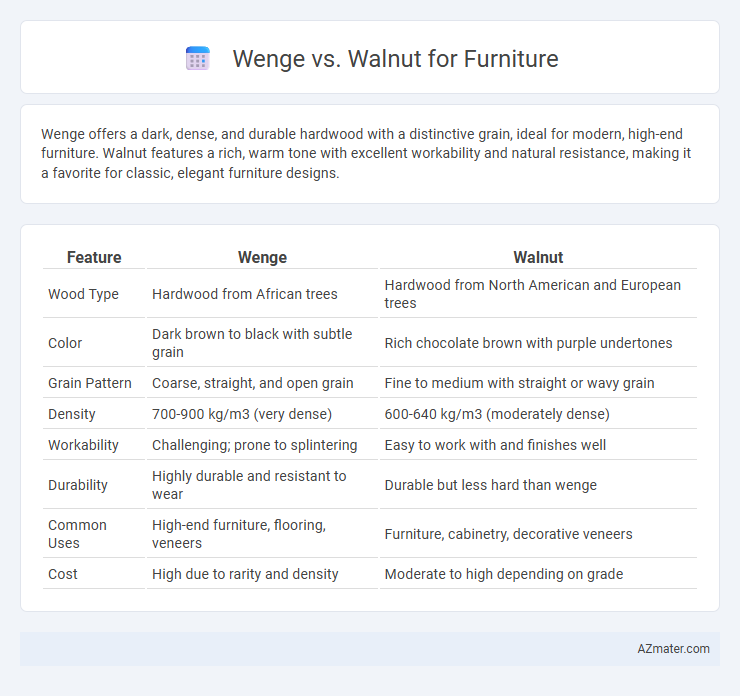Wenge offers a dark, dense, and durable hardwood with a distinctive grain, ideal for modern, high-end furniture. Walnut features a rich, warm tone with excellent workability and natural resistance, making it a favorite for classic, elegant furniture designs.
Table of Comparison
| Feature | Wenge | Walnut |
|---|---|---|
| Wood Type | Hardwood from African trees | Hardwood from North American and European trees |
| Color | Dark brown to black with subtle grain | Rich chocolate brown with purple undertones |
| Grain Pattern | Coarse, straight, and open grain | Fine to medium with straight or wavy grain |
| Density | 700-900 kg/m3 (very dense) | 600-640 kg/m3 (moderately dense) |
| Workability | Challenging; prone to splintering | Easy to work with and finishes well |
| Durability | Highly durable and resistant to wear | Durable but less hard than wenge |
| Common Uses | High-end furniture, flooring, veneers | Furniture, cabinetry, decorative veneers |
| Cost | High due to rarity and density | Moderate to high depending on grade |
Introduction to Wenge and Walnut
Wenge wood, derived from the Millettia laurentii tree native to Central Africa, is prized for its deep brown to black coloration with distinctive dark veins, offering a bold and exotic look for furniture. Walnut, primarily sourced from the Juglans genus in North America and Europe, features a rich, warm brown hue with a fine and straight grain, making it a classic choice for elegant and durable furnishings. Both woods combine strength and aesthetic appeal, but Wenge's dramatic contrast and Walnut's smooth, consistent texture cater to different design preferences and project requirements.
Appearance and Color Differences
Wenge wood features a rich, dark brown to almost black color with subtle, linear grain patterns, creating a bold and modern look ideal for contemporary furniture designs. Walnut boasts a warm, medium to dark brown hue with hints of purple or red and a more varied, swirling grain pattern that adds depth and classic elegance. The stark contrast between Wenge's deep, uniform coloration and Walnut's lighter, more textured appearance makes each suitable for different aesthetic preferences in furniture.
Grain Patterns and Texture
Wenge wood features a straight, coarse grain with a naturally rough texture, creating bold, dramatic patterns ideal for striking furniture pieces. Walnut showcases a fine, uniform grain with a smooth texture, providing a consistent and elegant appearance favored for classic and high-end designs. Both woods offer distinct aesthetic qualities, with Wenge delivering a modern, textured look and Walnut emphasizing warmth and refined smoothness.
Durability and Hardness Comparison
Wenge wood scores high on the Janka hardness scale at approximately 1630, making it exceptionally durable and resistant to dents and scratches, ideal for heavy-use furniture. Walnut, with a Janka rating of around 1010, offers moderate hardness, combining reasonable durability with easier workability for intricate designs. Choosing Wenge ensures superior toughness and longevity, while Walnut provides a balance of durability and aesthetic versatility.
Workability and Machining
Wenge wood offers excellent workability with its dense, coarse grain that machines smoothly but requires sharp tools to avoid chipping. Walnut is prized for its superior machinability, featuring a fine, straight grain that cuts cleanly and sands to a smooth finish with minimal effort. Both woods perform well for furniture making, but walnut is generally easier to shape and detail, while wenge demands more skill due to its hardness and tendency to splinter.
Cost and Availability
Wenge wood typically costs more than walnut due to its rarity and limited supply, making it a premium choice for high-end furniture. Walnut is more readily available in North America and Europe, contributing to its relatively lower and more stable price point. Both woods offer durability and aesthetic appeal, but budget-conscious buyers often prefer walnut for its accessibility and consistent availability.
Maintenance and Care
Wenge furniture requires careful maintenance to prevent scratches and fading, benefiting from regular dusting and occasional oiling to preserve its dark, rich color. Walnut is more resilient, needing less frequent oiling and can be cleaned with mild soap and water, making it easier to maintain in high-traffic areas. Both woods should be protected from excessive moisture and direct sunlight to extend their lifespan and retain their natural beauty.
Environmental Impact and Sustainability
Wenge wood, known for its dense grain and dark color, often comes from slow-growing African trees, leading to concerns about deforestation and habitat loss due to unsustainable harvesting practices. Walnut, typically sourced from North American and European forests, benefits from more regulated forestry management and reforestation efforts, reducing its environmental footprint compared to Wenge. Choosing walnut for furniture aligns better with sustainability goals, emphasizing responsible sourcing and lower ecological impact, whereas Wenge requires careful consideration of certification and legality.
Best Applications for Furniture Design
Wenge wood is best suited for modern, high-contrast furniture designs due to its deep, dark brown color and distinctive grain, making it ideal for statement pieces like coffee tables, cabinets, and flooring accents. Walnut offers versatility with its rich, warm tones and smooth texture, excelling in classic and contemporary furniture such as dining tables, chairs, and bedroom sets where durability and elegance are prioritized. Both woods benefit from finishes that highlight their natural beauty, but Wenge's hardness supports heavy-use applications, whereas Walnut provides a softer touch suitable for intricate carvings and detailed designs.
Choosing Between Wenge and Walnut
Choosing between Wenge and Walnut for furniture depends on desired aesthetics, durability, and budget. Wenge offers a dark, exotic appearance with exceptional hardness and resistance to wear, ideal for high-traffic areas, while Walnut provides a warm, medium-brown tone with a smooth grain and moderate hardness, appealing for classic elegance. Consider Wenge for modern, durable pieces and Walnut for timeless, versatile designs in both residential and commercial settings.

Infographic: Wenge vs Walnut for Furniture
 azmater.com
azmater.com